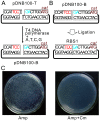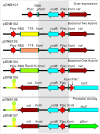Ribosomal binding site switching: an effective strategy for high-throughput cloning constructions
- PMID: 23185557
- PMCID: PMC3503710
- DOI: 10.1371/journal.pone.0050142
Ribosomal binding site switching: an effective strategy for high-throughput cloning constructions
Abstract
Direct cloning of PCR fragments by TA cloning or blunt end ligation are two simple methods which would greatly benefit high-throughput (HTP) cloning constructions if the efficiency can be improved. In this study, we have developed a ribosomal binding site (RBS) switching strategy for direct cloning of PCR fragments. RBS is an A/G rich region upstream of the translational start codon and is essential for gene expression. Change from A/G to T/C in the RBS blocks its activity and thereby abolishes gene expression. Based on this property, we introduced an inactive RBS upstream of a selectable marker gene, and designed a fragment insertion site within this inactive RBS. Forward and reverse insertions of specifically tailed fragments will respectively form an active and inactive RBS, thus all background from vector self-ligation and fragment reverse insertions will be eliminated due to the non-expression of the marker gene. The effectiveness of our strategy for TA cloning and blunt end ligation are confirmed. Application of this strategy to gene over-expression, a bacterial two-hybrid system, a bacterial one-hybrid system, and promoter bank construction are also verified. The advantages of this simple procedure, together with its low cost and high efficiency, makes our strategy extremely useful in HTP cloning constructions.
Conflict of interest statement
Figures






Similar articles
-
pXST, a novel vector for TA cloning and blunt-end cloning.BMC Biotechnol. 2018 Jul 13;18(1):44. doi: 10.1186/s12896-018-0456-8. BMC Biotechnol. 2018. PMID: 30005664 Free PMC article.
-
Generating in vivo cloning vectors for parallel cloning of large gene clusters by homologous recombination.PLoS One. 2013 Nov 11;8(11):e79979. doi: 10.1371/journal.pone.0079979. eCollection 2013. PLoS One. 2013. PMID: 24244585 Free PMC article.
-
A novel series of high-efficiency vectors for TA cloning and blunt-end cloning of PCR products.Sci Rep. 2019 Apr 23;9(1):6417. doi: 10.1038/s41598-019-42868-6. Sci Rep. 2019. PMID: 31015513 Free PMC article.
-
The use of two-cistron constructions in improving the expression of a heterologous gene in E. coli.Nucleic Acids Res. 1990 Apr 11;18(7):1711-8. doi: 10.1093/nar/18.7.1711. Nucleic Acids Res. 1990. PMID: 2110654 Free PMC article.
-
A bacterial three-hybrid assay for forward and reverse genetic analysis of RNA-protein interactions.Nat Protoc. 2022 Apr;17(4):941-961. doi: 10.1038/s41596-021-00657-4. Epub 2022 Feb 23. Nat Protoc. 2022. PMID: 35197605 Free PMC article. Review.
Cited by
-
High-throughput FastCloning technology: A low-cost method for parallel cloning.PLoS One. 2022 Sep 9;17(9):e0273873. doi: 10.1371/journal.pone.0273873. eCollection 2022. PLoS One. 2022. PMID: 36084059 Free PMC article.
References
-
- Scharf SJ, Horn GT, Erlich HA (1986) Direct cloning and sequence analysis of enzymatically amplified genomic sequences. Science 233: 1076–1078. - PubMed
Publication types
MeSH terms
LinkOut - more resources
Full Text Sources

